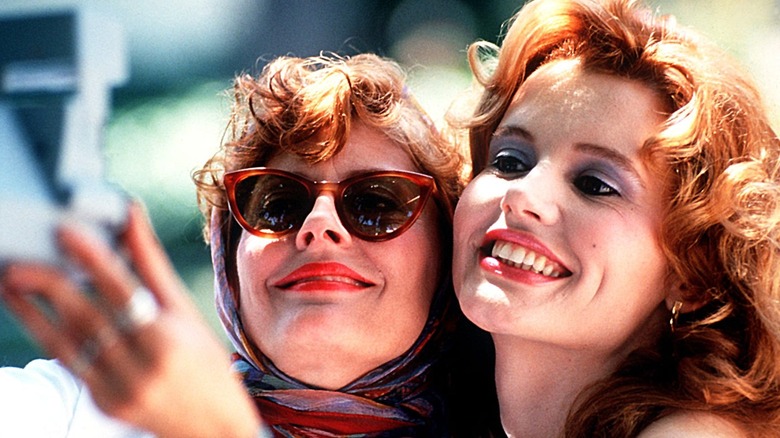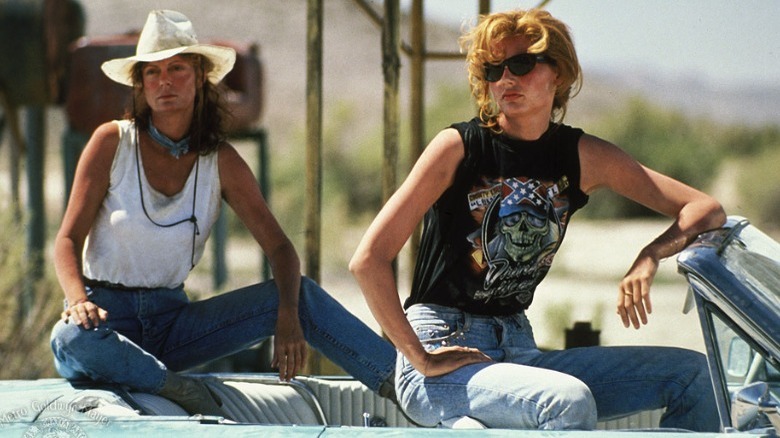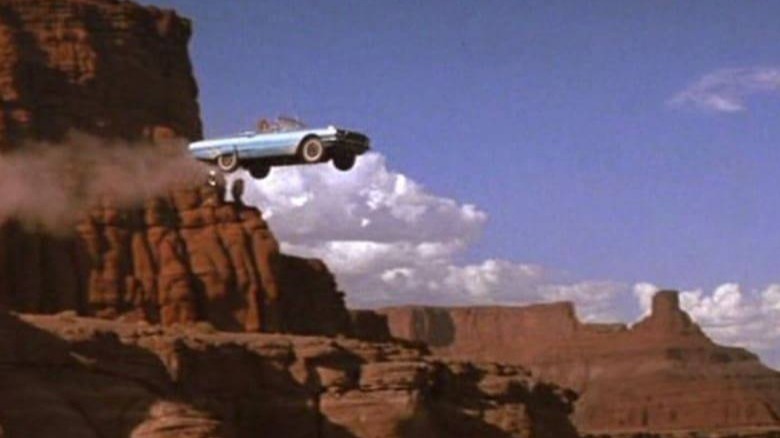How Thelma & Louise's Alternate Ending Would Have Completely Changed The Film
When Thelma (Geena Davis) and Louise (Susan Sarandon) held hands and plunged their blue 1966 Thunderbird into the Grand Canyon, it was an ending that would reverberate through cinema history. Ridley Scott's 1991 road movie about two women whose vacation turns into an exhilarating run for their lives features one of the truly definitive movie endings. Only, it turns out, it wasn't always going to end that way.
At least three other versions of the final scene of "Thelma & Louise" were discussed or shot before Scott landed on the fade-to-white freeze frame that shocked viewers upon the film's release. None of them are as powerful as the version we ended up with.
There Are Several Other Versions of The Ending
In an interview with Entertainment Weekly, Sarandon revealed that Ridley Scott considered having Louise push Thelma out of the car at the last minute, keeping her alive. Sarandon apparently wanted to stick with the finality of the original ending, telling Scott, "Don't have me do this and then when you test it and everybody gets bummed out, you're going to reshoot and we're going to be alive after all." Luckily, it didn't come to that. Sarandon says the film "earned that ending," which was the last scene the two actresses shot together.
A second version of the ending appears on the film's 20th anniversary Blu-Ray edition, according to Slate. In this extended scene, viewers actually see the car falling, and Harvey Keitel's detective character, Hal, looking at the wreckage while state troopers approach the ledge and a helicopter flies over. This cut ends with Hal picking up the Polaroid that blew out of the convertible during the fall and looking at the portrait of Thelma and Louise from the beginning of their ill-fated trip.
While this cut isn't available online, it doesn't seem drastically different from yet another extended ending available officially through the Vudu YouTube page. This scene, which is apparently also included on a DVD copy of the film, also features a shot of the car falling into the canyon. The shot is perhaps accidentally surreal, as the illusory depths of the landscape almost make the vehicle look like it's floating. As with the Blu-ray ending, the scene focuses on the state troopers and Keitel's character, and includes a shot of a helicopter headed into the canyon. Notably, though, there's no Polaroid in this shot.
This final alternate ending includes two major choices that change the tone of the film entirely. First, it includes B.B. King's song "Better Not Look Down" in place of the film's Hans Zimmer score. Second, it also includes a shot of the Thunderbird driving down another country road, this one surrounded by greenery. The car moves towards a hill in the distance, kicking up plenty of dust as it goes.
Flying Cars, B.B. King Songs, and More Keitel
Each of these proposed alternate endings would have undercut the power of Thelma and Louises' final, shocking commitment to their adventure. On one level, the film is a wildly entertaining crime story. On another, it's a thought-provoking look at two women running from the patriarchy — away from deadbeat husbands and abusive, obscene strangers and into the idealistic unknown. They go to the ends of the earth together to find a place where they can have some control over their futures. At a certain point, they can only find it together, in their final leap into the abyss.
Both the Blu-ray anniversary ending of the film and the version available on Vudu pull the focus away from the women, and back to the men who are trying to rein them in. By including so many shots of Hal and the state troopers, these endings frame the women as lost causes who leave the men of the world shaking their heads, rather than the anarchic firebrands they see themselves as. A shot of Hal looking at the Polaroid of the women would also frame the whole endeavor as a cautionary tale — look at how nice they were before it all went wrong! This, too, would undermine the rebellious spirit of the film's original ending.
Similarly, the inclusion of the B.B. King song changes the entire tone of the film. It ties a goofy, "Well would you look at that!" bow on the whole movie that both minimizes the power of Thelma and Louises' decision and instantly ages the film. With the Zimmer score, we can easily see how important this moment is, and recognize the crucial decision that helps cast every other aspect of the film in a new light. King's song makes it easy to disengage, to sit back and wait for the end credits to roll, and to shrug off the surprise ending without unpacking its impact on the story as a whole.
The Original Is Still The Most Powerful
Giving the film a too-happy ending would be just as ineffective. Both Scott's idea about Louise pushing Thelma out of the car, and the final shot of the car driving on the extended ending, are less impactful than the finale we got. Of all the choices made in the alternate endings, the car shot is the only one I don't totally hate. It gives us the idea that these women aren't sad about meeting their fate; that they're just moving on to another adventure. It's still unnecessary, though, as we can read all of that with crystal clarity in Sarandon's and Davis' faces.
"Let's keep going," Thelma tells Louise in every version of the final scene. The women are smiling, teary-eyed, the wind sweeping their hair into their dust-blown faces. Thelma and Louise end on their own terms, with nothing left to lose and everything to gain in their final act of togetherness. In the end, Ridley Scott scrapped the extra songs and shots, and gave "Thelma & Louise" one of the best endings in film history.


